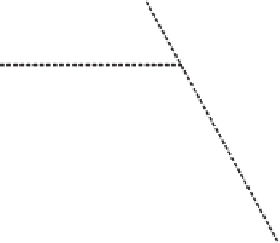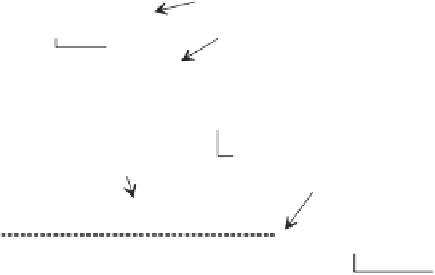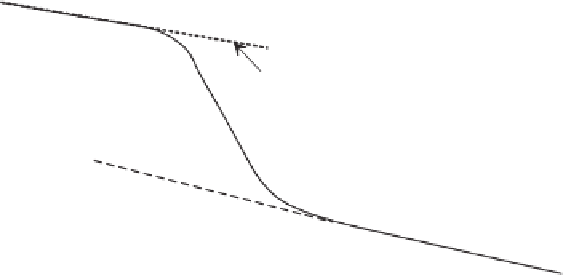Environmental Engineering Reference
In-Depth Information
The van Genuchten (1980)-Burdine (1953) equation can be
applied between the air-entry value and residual conditions.
Fredlund and Xing (1994)—Without the Correction
Factor.
The Fredlund and Xing (1994) equation for the
SWCC has a correction factor
C(ψ)
that extends the range
of suctions beyond residual suction to completely dry
conditions:
from a small suction value (e.g., 1 kPa) to the air-entry suction
ψ
aev
, (ii) an intermediate portion from the air-entry suction
ψ
aev
to the residual suction
ψ
r
, and (iii) a high-suction por-
tion from the residual suction
ψ
r
to 10
6
kPa, as shown in
Fig. 4.100. The water contents corresponding to the air-entry
value and residual suction must be known as well as the satu-
rated water content under low-suction conditions (e.g., 1 kPa)
in order to use these equations over the entire suction range.
Each suction range has a SWCC equation of a similar form.
The three equations cover the entire water content range from
completely saturated conditions to completely dry conditions
with each portion having a meaningful slope representing
water content versus suction. It is necessary to know the water
contents at the start and end points for each line segment.
The slope of the straight-line portions of the three zones are
defined as
S
1
,
S
2
, and
S
3
, when going from the low-suction
range of the SWCC curve to the high-suction range.
The SWCC equation for the low-suction range,
intermediate-suction range, and high-suction range can be
written as follows:
w
s
ln
e
+
ψ
a
n
m
w
(ψ)
=
C (ψ)
(4.44)
where:
a, n
,
m
=
fitting soil parameters for the SWCC,
e
=
base of the natural logarithm,
ln
1
+
ψ
/
ψ
r
ln
1
+
1000000
/
ψ
r
, and
C(ψ)
=
correction factor, 1
−
ψ
r
=
soil suction at residual conditions, kPa.
It is not easy to rearrange the Fredlund and Xing (1994)
equation and solve for soil suction when the “correction
factor” is kept within the equation. Therefore, the correction
factor for suctions greater than residual suction is set to 1.0.
The Fredlund and Xing (1994) equation for calculating soil
suction in terms of water content can then be written as
follows:
w
1
(ψ)
=
w
u
−
S
1
log
(ψ)
1
≤
ψ<ψ
aev
w
aev
−
S
2
log
ψ
ψ
aev
w
2
(ψ)
=
ψ
aev
≤
ψ<ψ
r
w
3
(ψ)
=
S
3
log
10
6
ψ
≤
ψ<
10
6
kPa
ψ
r
ψ
=
a
e
(
w
s
/
w)
1
/m
−
e
1
/n
(4.46)
(4.45)
where:
w
u
=
water content corresponding to a suction of 1 kPa
and
A numerical technique must be used to compute soil suc-
tion from a water content measurement if the entire Fredlund
and Xing (1994) equation along with the correction factor
is used.
Fredlund and Pham (2006).
Fredlund and Pham (2006)
divided the SWCC into three zones: (i) a low-suction portion
w
aev
=
water content corresponding to the air-entry
value, %.
Each of the above equations can be rearranged to solve for
suction in terms of water content. The equations for the low
w
2
(
ψ
)
S
1
w
sat
w
aev
First break in SWCC
(Air-entry value)
w
1
(
ψ
)
S
2
w
3
(
ψ
)
Second break in SWCC
(residual conditions)
w
r
S
3
10
6
0.1
1
10
100
1000
10,000
100,000
ψ
aev
ψ
r
Soil suction, kPa
Figure 4.100
Three primary zones of desaturation for drying SWCC (Fredlund and Pham, 2006).


















Search WWH ::

Custom Search